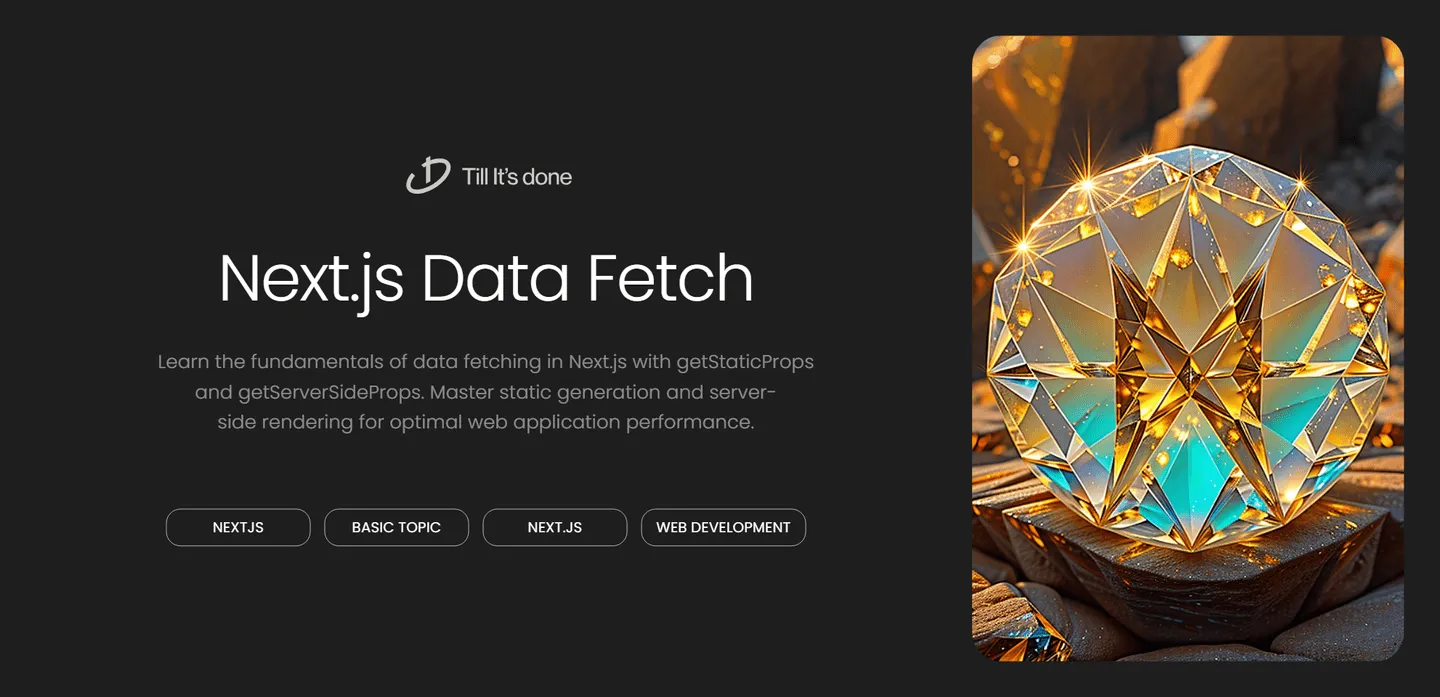- Services
- Case Studies
- Technologies
- NextJs development
- Flutter development
- NodeJs development
- ReactJs development
- About
- Contact
- Tools
- Blogs
- FAQ
Data Fetching in Next.js: A Complete Guide
Master static generation and server-side rendering for optimal web application performance.


Introduction to Data Fetching in Next.js: getStaticProps and getServerSideProps
Data fetching is at the heart of modern web applications, and Next.js provides powerful built-in solutions to handle it efficiently. Today, let’s dive into two fundamental data fetching methods: getStaticProps and getServerSideProps. Whether you’re building a blog, e-commerce site, or dashboard, understanding these concepts will help you create faster, more efficient web applications.

Understanding Static Generation with getStaticProps
Think of getStaticProps as your pre-party preparation. Just like how you’d prepare snacks and decorations before guests arrive, getStaticProps prepares your data before visitors hit your website. This method runs at build time, gathering all the necessary data and generating static HTML pages.
Here’s a practical example:
export async function getStaticProps() { // Fetch blog posts from an API const posts = await fetch('https://api.example.com/posts') .then(res => res.json())
return { props: { posts, // Will be passed to the page component as props }, revalidate: 60 // Optional: Regenerate page every 60 seconds }}The beauty of getStaticProps lies in its performance benefits. Since pages are generated at build time, your users receive lightning-fast, pre-rendered content without waiting for server-side operations.

Server-Side Rendering with getServerSideProps
Now, let’s talk about getServerSideProps – your real-time data butler. Unlike getStaticProps, this method runs on every request, making it perfect for pages that need fresh data every time they’re loaded.
Here’s how you might use it:
export async function getServerSideProps(context) { // Fetch user-specific dashboard data const userData = await fetch(`https://api.example.com/user/${context.params.id}`) .then(res => res.json())
return { props: { userData, } }}Think of it like a live news broadcast versus a recorded show. While static generation (getStaticProps) is like a pre-recorded show that everyone watches, server-side rendering (getServerSideProps) is like a live broadcast, delivering fresh content for every viewer.
Choosing Between the Two
The choice between getStaticProps and getServerSideProps often comes down to your specific needs:
-
Use getStaticProps when:
- Your data doesn’t change frequently
- You want the fastest possible page loads
- SEO is a top priority
-
Use getServerSideProps when:
- You need real-time data
- Pages must be personalized for each user
- Content depends on user-specific context
Remember, there’s no one-size-fits-all solution. Many successful Next.js applications use both methods strategically across different pages.
Best Practices and Tips
- Always handle errors gracefully in both methods
- Use appropriate caching strategies
- Consider using Incremental Static Regeneration (ISR) with getStaticProps for the best of both worlds
- Monitor performance impacts of your chosen method

 สร้างเว็บไซต์ 1 เว็บ ต้องใช้งบเท่าไหร่? เจาะลึกทุกองค์ประกอบ website development cost อยากสร้างเว็บไซต์แต่ไม่มั่นใจในเรื่องของงบประมาณ อ่านสรุปเจาะลึกตั้งแต่ดีไซน์, ฟังก์ชัน และการดูแล พร้อมตัวอย่างงบจริงจาก Till it’s done ที่แผนชัด งบไม่บานปลายแน่นอน
สร้างเว็บไซต์ 1 เว็บ ต้องใช้งบเท่าไหร่? เจาะลึกทุกองค์ประกอบ website development cost อยากสร้างเว็บไซต์แต่ไม่มั่นใจในเรื่องของงบประมาณ อ่านสรุปเจาะลึกตั้งแต่ดีไซน์, ฟังก์ชัน และการดูแล พร้อมตัวอย่างงบจริงจาก Till it’s done ที่แผนชัด งบไม่บานปลายแน่นอน  Next.js สอน 14 ขั้นตอนเบื้องต้น: สร้างโปรเจกต์แรกใน 30 นาที เริ่มต้นกับ Next.js ใน 14 ขั้นตอนเพียงแค่ 30 นาที พร้อม SSR/SSG และ API Routes ด้วยตัวอย่างโค้ดง่าย ๆ อ่านต่อเพื่อสร้างโปรเจ็กต์แรกได้ทันทีที่นี่
Next.js สอน 14 ขั้นตอนเบื้องต้น: สร้างโปรเจกต์แรกใน 30 นาที เริ่มต้นกับ Next.js ใน 14 ขั้นตอนเพียงแค่ 30 นาที พร้อม SSR/SSG และ API Routes ด้วยตัวอย่างโค้ดง่าย ๆ อ่านต่อเพื่อสร้างโปรเจ็กต์แรกได้ทันทีที่นี่  วิธีสมัคร Apple Developer Account เพื่อนำแอปขึ้น App Store ทีละขั้นตอน อยากปล่อยแอปบน App Store ระดับโลก มาอ่านคู่มือสมัคร Apple Developer Account พร้อมเคล็ดลับ TestFlight และวิธีอัปโหลดที่ง่ายในบทความเดียวนี้ได้เลย
วิธีสมัคร Apple Developer Account เพื่อนำแอปขึ้น App Store ทีละขั้นตอน อยากปล่อยแอปบน App Store ระดับโลก มาอ่านคู่มือสมัคร Apple Developer Account พร้อมเคล็ดลับ TestFlight และวิธีอัปโหลดที่ง่ายในบทความเดียวนี้ได้เลย  TypeScript Interface คืออะไร? อธิบายพร้อมวิธีใช้และข้อแตกต่างจาก Type เรียนรู้วิธีใช้ TypeScript Interface เพื่อสร้างโครงสร้างข้อมูลที่ปลอดภัยและเข้าใจง่าย พร้อมเปรียบเทียบข้อดีข้อแตกต่างกับ Type ที่คุณต้องรู้ ถูกรวมเอาไว้ในบทความนี้แล้ว
TypeScript Interface คืออะไร? อธิบายพร้อมวิธีใช้และข้อแตกต่างจาก Type เรียนรู้วิธีใช้ TypeScript Interface เพื่อสร้างโครงสร้างข้อมูลที่ปลอดภัยและเข้าใจง่าย พร้อมเปรียบเทียบข้อดีข้อแตกต่างกับ Type ที่คุณต้องรู้ ถูกรวมเอาไว้ในบทความนี้แล้ว  Material-UI (MUI) คืออะไร อยากสร้าง UI สวยงามและเป็นมืออาชีพในเวลาอันรวดเร็วใช่ไหม มาทำความรู้จักกับ Material-UI (MUI) ที่ช่วยให้คุณพัฒนาแอปพลิเคชันบน React ได้ง่ายและดูดีในทุกอุปกรณ์
Material-UI (MUI) คืออะไร อยากสร้าง UI สวยงามและเป็นมืออาชีพในเวลาอันรวดเร็วใช่ไหม มาทำความรู้จักกับ Material-UI (MUI) ที่ช่วยให้คุณพัฒนาแอปพลิเคชันบน React ได้ง่ายและดูดีในทุกอุปกรณ์  เปรียบเทียบ 3 วิธีติดตั้ง install node js บน Ubuntu: NVM vs NodeSource vs Official Repo แบบไหนดีที่สุด? เรียนรู้วิธีติดตั้ง Node.js บน Ubuntu ด้วย NVM, NodeSource หรือ Official Repo เลือกวิธีที่เหมาะกับความต้องการของคุณ พร้อมเปรียบเทียบ เพื่อการพัฒนาที่มีประสิทธิภาพ!
เปรียบเทียบ 3 วิธีติดตั้ง install node js บน Ubuntu: NVM vs NodeSource vs Official Repo แบบไหนดีที่สุด? เรียนรู้วิธีติดตั้ง Node.js บน Ubuntu ด้วย NVM, NodeSource หรือ Official Repo เลือกวิธีที่เหมาะกับความต้องการของคุณ พร้อมเปรียบเทียบ เพื่อการพัฒนาที่มีประสิทธิภาพ! พูดคุยกับซีอีโอ
We'll be right here with you every step of the way.
We'll be here, prepared to commence this promising collaboration.
Whether you're curious about features, warranties, or shopping policies, we provide comprehensive answers to assist you.


